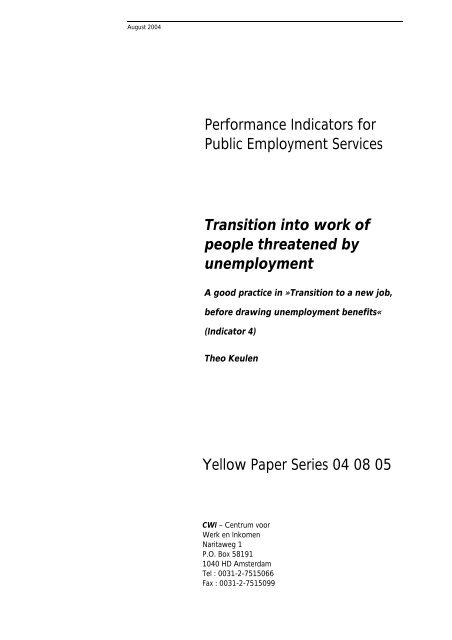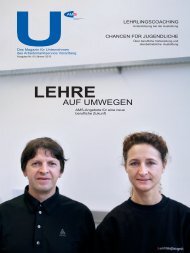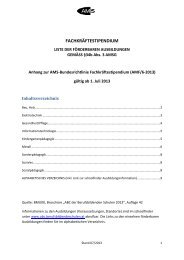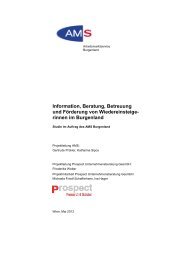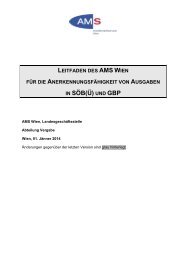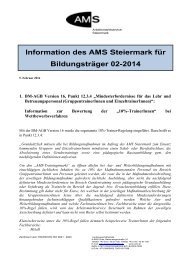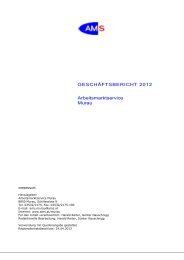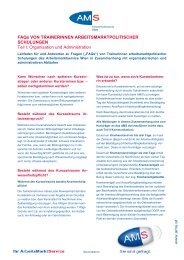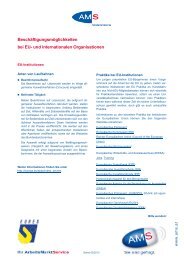Performance Indicators for Public Employment Services Transition ...
Performance Indicators for Public Employment Services Transition ...
Performance Indicators for Public Employment Services Transition ...
Create successful ePaper yourself
Turn your PDF publications into a flip-book with our unique Google optimized e-Paper software.
August 2004<br />
<strong>Per<strong>for</strong>mance</strong> <strong>Indicators</strong> <strong>for</strong><br />
<strong>Public</strong> <strong>Employment</strong> <strong>Services</strong><br />
<strong>Transition</strong> into work of<br />
people threatened by<br />
unemployment<br />
A good practice in »<strong>Transition</strong> to a new job,<br />
be<strong>for</strong>e drawing unemployment benefits«<br />
(Indicator 4)<br />
Theo Keulen<br />
Yellow Paper Series 04 08 05<br />
CWI – Centrum voor<br />
Werk en Inkomen<br />
Naritaweg 1<br />
P.O. Box 58191<br />
1040 HD Amsterdam<br />
Tel : 0031-2-7515066<br />
Fax : 0031-2-7515099
Foreword<br />
The selection of good practice examples among Member-PES<br />
is the ultimate purpose of the benchmarking exercise with<br />
respect to per<strong>for</strong>mance of <strong>Public</strong> <strong>Employment</strong> <strong>Services</strong>.<br />
The following presentation of a good practice is related to<br />
the goal reflected by Indicator 4 (»<strong>Transition</strong> to a new job,<br />
be<strong>for</strong>e drawing unemployment benefits«).<br />
The presentation of the Good Practice has been prepared by<br />
Theo Keulen, a Member of the Working Group.<br />
The Group Member takes the responsibility <strong>for</strong> this paper.<br />
For the Consultant´s team<br />
Prof. Michael Wagner-Pinter<br />
Vienna, August 2004
Good practice presentation<br />
Good Practice Profile<br />
»<strong>Transition</strong> into work of people threatened by unemployment«<br />
Name of the <strong>Public</strong> <strong>Employment</strong> Service Central Organisation Work en Income<br />
Address of the <strong>Public</strong> <strong>Employment</strong> Service: Naritaweg 1,<br />
Postbox 58191, 1040 HD Amsterdam<br />
Working title <strong>for</strong> the good practice described: <strong>Transition</strong> into work of people threatened by<br />
unemployment (prevention of drawing benefits)<br />
Give a short description of the good practice.<br />
A more detailed description might be put in an<br />
appendix.<br />
Benchmarking result responsible <strong>for</strong> the<br />
selection of the PES:<br />
Representative in the Working Group:<br />
– Name<br />
– e-mail:<br />
Person in charge of preparing the<br />
good practice presentation:<br />
– Name<br />
– e-mail:<br />
3<br />
Placing / mediating of people during the period between<br />
the notice of dismissal and the first day of their<br />
entitlement to benefits. These people , who aren’t obliged<br />
to come to the CWI’s after notice, are invited to come as<br />
soon as possible so that they may be supported to obtain<br />
new employment be<strong>for</strong>e their entitlement come into<br />
<strong>for</strong>ce.<br />
( CWI as gatekeeper to social security)<br />
This indicator wasn’t subject <strong>for</strong> benchmarking because<br />
this practice is only identified in the Netherlands. This<br />
indicator was introduced in 2003. The results <strong>for</strong> 2003<br />
are:<br />
17,3 % of the persons who were registered as jobseekers<br />
threatened by future unemployment obtained a new job<br />
be<strong>for</strong>e the period in which they would be entitled to<br />
benefits should start.<br />
Theo Keulen<br />
Theo.Keulen@cwinet.nl<br />
See above
Is the per<strong>for</strong>mance indicator 4 part of<br />
the set of explicitly stated<br />
per<strong>for</strong>mance goals of PES »CWI«?<br />
Is a numerical target value attached to the<br />
goal?<br />
Do regional offices (or functional departments)<br />
get recognition <strong>for</strong> achieving this goal?<br />
Good practice presentation<br />
4<br />
One of the major objectives of CWI is to enhance the<br />
development and to “utilize” the talents <strong>for</strong> the labour<br />
market in order to prevent or to shorten the dependency<br />
on benefits. For this objective some indicators are<br />
explicitly included in the Balanced Score Card of CWI.<br />
Indicator 4 is one of them. The other ones are :<br />
prevention ratio social assistance benefits, outflowratios<br />
and gatekeeperratios.<br />
The numerical value <strong>for</strong> the year 2003 was 25%. For<br />
2004 the value is 18%<br />
Yes, it included in the balanced scorecard which is<br />
available per local CWI. The progress is monitored<br />
weekly, also by internal benchmarking. The recognition a<br />
local office may get is the position on the ranking lists.<br />
These lists are accessible on the Intranet.<br />
What is the basic idea of the good practice? To reduce the number of claimants and to reduce the<br />
period of dependency on social security.<br />
Another reason relates to the experience that people who<br />
are still at work have better chances to be re-employed<br />
because their work experiences may be profitable <strong>for</strong><br />
employers.<br />
Last but no least the leading principle <strong>for</strong> CWI operations<br />
Who are the main agents of this good<br />
practice?<br />
How many organizational units (in regional or<br />
functional terms) are involved?<br />
Do the units involved operate<br />
– as part of the PES?<br />
– on a contractual basis with the PES?<br />
– independently of the PES?<br />
is “Work first”<br />
The local CWI’s<br />
131<br />
As part of the PES
Which resources are made available to carry<br />
out the practice as designed?<br />
Which share of the total financial resources of<br />
PES »CWI« is allocated to the good practice?<br />
Is the good practice targeted at specific groups<br />
of unemployed people?<br />
How are the participants (or addressees) of the<br />
good practice selected?<br />
How large is the group of participants as<br />
percentage of all potential addressees?<br />
How does the good practice affect the<br />
numerical value of the per<strong>for</strong>mance indicator<br />
Has the good practice an explicit gender<br />
mainstreaming dimension?<br />
Does gender mainstreaming show up in the<br />
good practice?<br />
Good practice presentation<br />
5<br />
This practice is at the core business of CWI and so the<br />
resources are included in the yearly budget of the CWI’s.<br />
This budget is based on the number of customers in<br />
combination with the estimated services delivered to the<br />
customers.<br />
As explained above no special resources are allocated to<br />
this practice<br />
Yes, those people who are threatened by future<br />
unemployment. In fact they aren’t unemployment a<br />
defined as being out of a job , entitled to a benefit and<br />
obliged to search actively <strong>for</strong> a job.<br />
There isn’t a special selection procedure. At the occasion<br />
of the first intake at which they are assessed they are<br />
confronted with work opportunities. Their search<br />
behaviour is monitored.<br />
As we don’t know how much people are dismissed during<br />
the year we don’t know the percentage<br />
The numerical value is strongly dependent on the local<br />
labour market. The more this situation improves the<br />
numerical value may increase.<br />
no<br />
Although there aren’t indicators defined <strong>for</strong> gender the<br />
outcome <strong>for</strong> men and women is 18,2 resp 15,9 %
Are the results of the good practice regularly<br />
monitored?<br />
Has the good practice been evaluated by<br />
independent experts?<br />
Is there room <strong>for</strong> improvement in the<br />
implementation of the good practice?<br />
Have there been major revisions in the<br />
implementation of the good practice?<br />
How does the good practice fit into the general<br />
strategy of the PES?<br />
Has the introduction of the good practice<br />
caused a shift of PES-resources away from<br />
other programmes?<br />
Does the good practice cause »costs« (other<br />
than monetary and personnel resources) <strong>for</strong><br />
the PES?<br />
Good practice presentation<br />
6<br />
As already stated CWI makes use of Balanced Score Cards<br />
which are specified to the local level. The monitoring of<br />
the development of this indicator is a permanent item on<br />
the agenda of the two weekly meeting of the Board of<br />
Directors.<br />
The results are also quarterly discussed in the monitoring<br />
meetings with the Districtmanagers who also discuss<br />
these with the local managers.<br />
No<br />
Although this indicator was introduced in 2003 there is<br />
always room <strong>for</strong> improvement like e.g. by giving access to<br />
a larger number of vacancies, improving matching<br />
instruments, attracting customers in earlier stage etc.<br />
no<br />
This practice belongs to the core business of CWI whose<br />
tasks / assignments are included in the law by which a<br />
new structure of social security and employment services<br />
is established. The level of the indicator is object of<br />
negotiations with the Minister of Social Affairs and<br />
<strong>Employment</strong> .<br />
No, CWI doesn’t execute active labour market<br />
programmes. Introducing of this practice may have<br />
interfered with the “more or less” administrative tasks<br />
with regard to the benefit intake which CWI have to do<br />
under the new structure.<br />
no
How have the employees of the PES perceived<br />
the introduction of the good practice in terms<br />
of their own per<strong>for</strong>mance and career with the<br />
PES?<br />
Has the (potential) impact of the introduction<br />
on established routines of providing services<br />
been explicitly addressed by a »change<br />
management process«?<br />
Has the introduction of the good practice<br />
changed the perception of the quality of PESservices<br />
by customers/political decision makers/<br />
the general public?<br />
Are there features of the good practice which<br />
are likely to be transferable to other PES<br />
working under different conditions?<br />
Has there been scepticism among (external or<br />
internal) experts vis-à-vis the good practice?<br />
Good practice presentation<br />
7<br />
The objectives are fully accepted. The advisors were<br />
pleased to some extent that more attention is given to<br />
placing. The development is supported by internal training<br />
programme related to gatekeeping. Employees are<br />
obliged this training to obtain the required certificate<br />
The implementation was planned and supported by<br />
implementation coaches<br />
Our partners in the chain of service delivery ( benefit<br />
agency and municipalities) as well as the Minister (<br />
politicians) have a great interest in this per<strong>for</strong>mance<br />
indicator in reducing social costs. ( Work first). In the client<br />
surveys no special attention is given to this practice.<br />
The new structure has certainly a impact on the perception<br />
of the customer jobseeker because the customers are<br />
more explicitly confronted with their obligations and their<br />
rights.<br />
To place more people CWI needs more vacancies , extra<br />
attention is given to services to employers. Their<br />
satisfaction is increased.<br />
This practice can be seen as a way of filling the “ early<br />
identification – early action approach ‘” which is included<br />
in the European <strong>Employment</strong> Strategy ( guideline 1 ). As<br />
such each PES may utilize this practice.<br />
However transferability should be assessed within the<br />
context of the position and the role of the PES in relation<br />
to social security.<br />
There wasn’t scepticism internally but the implementation<br />
of this practice was critical from the angle of organising<br />
sufficient personal capacity placing and services to<br />
employers. Because at the same time the unemployment<br />
was increasing which meant a lot of extra intakes and the<br />
number of vacancies was decreasing.


